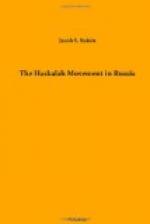It was not merely because of its business facilities that England appealed to the Slavonic Jews. Baruch Shklover, or Schick (1740-1812), went thither to study medicine, and it was from English literature that he selected the material for his Keneh ha-Middah (Prague, 1784; Shklov, 1793), on trigonometry. It would appear that the first Hebrew book, Toledot Ya’akob, printed for a Jew in England, was, as the name of the author, Eisenstadt, suggests, that of a Slavonic Jew. Although a silversmith by profession, Israel Lyons (d. 1770) was appointed teacher of Hebrew at the University of Cambridge. He acquired repute as a Hebrew scholar, and published, in 1757, the Scholar’s Instructor, or Hebrew Grammar (4th ed., 1823), and in 1768 a treatise printed by the Cambridge Press, Observations and Inquiries Relating to Various Parts of Scripture History. In the same chosen field labored Hyman Hurwitz (1770-1844), the friend of Coleridge, who founded the Highgate Academy (1799), and wrote an Introduction to Hebrew Grammar, Vindica Hebraica, and Hebrew Tales, which were translated into various languages. He finally became professor of Hebrew in University College, London.
A younger contemporary of Abrahamson, the Jewish German medallist, was Solomon (Yom Tob) Bennett (1780-1841), the engraver of Polotsk, who spent a number of years at Copenhagen and Berlin in perfecting himself in his art. Among his works is a highly praised bas-relief of Frederick II, which was much admired by the professors of the Academy. An ardent lover of liberty, of which there was little more in Germany at that time than in Russia, he left for England, where he spent the remaining years of his life, in Bristol. Besides being an artist and an engraver he was a profound theologian, anxious to defend the cause of Judaism against enemies within and without. The enemy within he attacked in his cutting criticism of Solomon Cohen’s Rudiments of Religion, and the enemy outside, in his other work, The Constancy of Israel (Nezah Yisrael, London, 1809). He also wrote expositions on many important Biblical topics, such as sacrifices (1815) and the Temple (1824). Having pointed out the defects of the Authorized Version (1834), he was ambitious of publishing a complete revised translation of the Bible. Specimens appeared in 1841. Death intervened and frustrated his plans. As Schick was the first Jew to translate from English into Hebrew, so Bennett was the first after Manasseh ben Israel to write in English in behalf of his people.[35]




